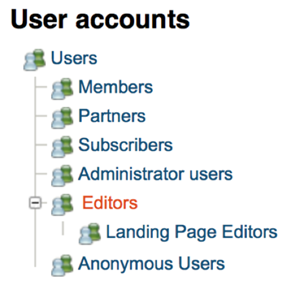5 Features Your Content Management System Must Have
Deciding when and how to upgrade your Content Management System (CMS) is not a decision to be taken  lightly. Therefore, since November, here at CMS-Connected, we have been publishing a series of articles that inquires whether keeping current with version upgrades makes you save money or are you throwing money away. To do so, as you may recall, we interviewed Mark Grannan of Forrester Research to get an analyst perspective, we sat down with Heather MacFayden of Falcon-Software to get an integration standpoint, and most recently we spoke with Corina Ursu of Regency Fireplace Products to get a perspective from the client-side. After hearing from these 3 different integral angles, now, we know that upgrading your website may necessitate time and budget but the opportunity cost can easily add up to be more than your total cost of having the right technology in place. So, today’s question is what are the right features that your CMS must have?
lightly. Therefore, since November, here at CMS-Connected, we have been publishing a series of articles that inquires whether keeping current with version upgrades makes you save money or are you throwing money away. To do so, as you may recall, we interviewed Mark Grannan of Forrester Research to get an analyst perspective, we sat down with Heather MacFayden of Falcon-Software to get an integration standpoint, and most recently we spoke with Corina Ursu of Regency Fireplace Products to get a perspective from the client-side. After hearing from these 3 different integral angles, now, we know that upgrading your website may necessitate time and budget but the opportunity cost can easily add up to be more than your total cost of having the right technology in place. So, today’s question is what are the right features that your CMS must have?
Since the requirements of a content management system have changed at an accelerated rate, click here for our updated 2019 edition highlighting the top features your modern CMS system should have.
Flexible Content Repositories
The days of single channel user engagement are long gone. Today, if you want your CMS a catalyst for your growth, you need to pick one that has a fine separation between content and presentation, so content creators wouldn’t need to be concerned about how every single front-end displays content. Instead, they can work with structured content. That’s where repositories come into play as they make your any type of content structured and accessible. Why would I need to structure my content, you may ask. Well, you can separate your content into independent parts so every separate entity can be edited independently or repurposed. As a result, you can:
-
Give your visitors flexibility that helps them find what they are looking for on your site or app
-
Recommend your visitors related content so they could explore what else your website has to offer that they otherwise would never have thought of.
-
Create semantic relationships between pieces of content which drastically bolsters the user experience.
-
Deliver a personalized user experience through dynamic content for a target audience.
-
Provide various levels of access to your content for monetization
Open APIs
First thing first, what is API? It is a term has been thrown around by all the tech companies. Even Mark  Zuckerberg includes it in his keynotes but as a marketer or a purchasing director, how are you are supposed to know what it means, right? Right! API stands for Application Programming Interface and allows the exchange of data between different systems. In other words, an API is a software intermediary that makes it possible for application programs to interact with each other and share data.
Zuckerberg includes it in his keynotes but as a marketer or a purchasing director, how are you are supposed to know what it means, right? Right! API stands for Application Programming Interface and allows the exchange of data between different systems. In other words, an API is a software intermediary that makes it possible for application programs to interact with each other and share data.
Now that we know the advantage of having a flexible repository and what API means, let me tell you that the combination of a flexible repository and open APIs makes it possible to deliver content beyond the web. Why would you need to go beyond the web, you may ask. Well, in that case, first of all, welcome to 2017 and secondly, by 2020, Gartner, the independent research firm, estimates tens of billions of everyday devices will be equipped with sensors to process and analyze data.
Let explain how an open API can help you go beyond the web by putting it into perspective. With the CMS’ APIs, an app developer can build a targeted app using existing content to drive a business value. In that way, you can repurpose the existing content in an eBook, on websites, mobile, native apps, Facebook Messenger, and other platforms.
Another benefit of open APIs is that you can integrate your CMS with other internal and external systems such as ERP, CRM systems that you already have in place. If you have an e-commerce website, for instance, you might want to facilitate a connection between your CMS and your payment processing systems. To do so, you will need to have either out-of-the-box connectors between the CMS and your other systems or technical team that can build the integrations the business needs.
Content Personalization
According to Forbes’ study entitled “Publish or Perish analysis of 380 CMOs”, marketers that deliver personalized web experiences are getting double digit returns in marketing performance and response. Good news more and more CMS vendors adopt stronger, more tightly integrated personalization capabilities due to the demand for personalized experiences. For example, a month ago, Episerver announced three more additions to its Omnichannel Personalization Suite, based on its most recent acquisitions of Peerius, a provider of intelligent omnichannel personalization in the cloud, and Optivo, a provider of omnichannel campaign management and customer intelligence solutions. On the heels of the new offerings, I interviewed James Norwood, Executive Vice President of Strategy and CMO at Episerver, to inquire what their new capabilities mean for the future of personalization and omnichannel in the CMS space. You can read the full interview, here.
 Alison Lewis, CMO at Johnson & Johnson, said: “Getting the right message to the right person at the right time has never been easier, driven by digital and data. Content needs are exploding as we move to a world of precision marketing and 24/7 engagement.” I couldn’t agree more with her. The technology has finally started catching up with the demand for personalization. Some CMS' provide personalization capabilities out of the box while others will integrate a third-party cloud service—some CMS' even offer connectors for major SaaS solutions. As Lewis said it has never been easier to deliver personalized content but personalization is still a sophisticated and complex area so make sure you have a solid grasp on what your goals are and what to expect. From there, you can start digging into the technology. Learn more on the impact of personalization on the future of the WCM market, here.
Alison Lewis, CMO at Johnson & Johnson, said: “Getting the right message to the right person at the right time has never been easier, driven by digital and data. Content needs are exploding as we move to a world of precision marketing and 24/7 engagement.” I couldn’t agree more with her. The technology has finally started catching up with the demand for personalization. Some CMS' provide personalization capabilities out of the box while others will integrate a third-party cloud service—some CMS' even offer connectors for major SaaS solutions. As Lewis said it has never been easier to deliver personalized content but personalization is still a sophisticated and complex area so make sure you have a solid grasp on what your goals are and what to expect. From there, you can start digging into the technology. Learn more on the impact of personalization on the future of the WCM market, here.
To deliver a personalized experience, you, typically, will need a CMS that has or can smoothly integrate personalization capabilities based on user behavior such as clicks, page views, and purchases as well as demographic data like location, language, job role, industry, and so on.
Permission Control
Organizations have different types of content and different kinds of job roles. Just because an organization  has many content writers doesn’t mean all of them have to be authorized as publishers. Or a person within the organization is simply allowed to publish only certain types of content such as job postings, while others might be able to publish only in certain parts of the site. The combinations can be multiplied more but my point is that tiered publishing capability is a feature your CMS must have.
has many content writers doesn’t mean all of them have to be authorized as publishers. Or a person within the organization is simply allowed to publish only certain types of content such as job postings, while others might be able to publish only in certain parts of the site. The combinations can be multiplied more but my point is that tiered publishing capability is a feature your CMS must have.
When you are deciding on your CMS technology, you should inquire what each level can do, if users can be designated with multiple roles, and in how many users there are for each permission level. The platform should allow the admin to add new user levels or adjust powers specifically for each user and should be truly optimized for your organization structure. After all, this feature adds a formidable layer of security, so your vendor should be able to explain what mechanisms are used to achieve a secure system.
Multilingual support
 Due to the continued growth in global mobile and e-commerce; the internet of things (IoT); and legislation requiring access to language services for immigrants, refugees, in the courts, and for public safety, the distinction between domestic and global market is shrinking. In fact, according to 2016 Forrester Consulting study commissioned by SDL that surveyed 151 organizations across the U.S. revealed that 48% of business and IT professionals are planning to move to a global content operating model within the next 24 months. However, the same study also found out that 92% of companies face challenges as they translate content into different languages and only 29% integrate their content management system with a translation management system or language service provider.
Due to the continued growth in global mobile and e-commerce; the internet of things (IoT); and legislation requiring access to language services for immigrants, refugees, in the courts, and for public safety, the distinction between domestic and global market is shrinking. In fact, according to 2016 Forrester Consulting study commissioned by SDL that surveyed 151 organizations across the U.S. revealed that 48% of business and IT professionals are planning to move to a global content operating model within the next 24 months. However, the same study also found out that 92% of companies face challenges as they translate content into different languages and only 29% integrate their content management system with a translation management system or language service provider.
If you’ve already targeted an international audience, or you have plans to cross borders in the future, you need to consider a CMS that can meet your multilingual CMS requirements. Many CMS vendors provide multilingual capabilities through plugins or extensions. The problem with this type of offering is that plugins can go unmaintained as they are not created by the actual CMS vendor and introduce vulnerabilities. The malware also can sneak in from third-parties. In that case, an out-of-the-box multilingual feature is a better alternative to consider as it is known to be more secure in terms of vulnerability and can be maintained better as it is a part of the vendor’s offering.
When you are inquiring about the multilingual capabilities of a platform, make sure it has at least the ability to fully customize URLs, is capable of supporting more translations than you currently need, and has a language switcher so the user experience wouldn’t be interrupted once the language has switched.
Gartner estimates that $77 billion of revenue will be created by more than 268 billion global downloads by 2017. Yet more than half of the countries on the top 10 list of application downloads and revenue are those in non-English-speaking nations in Europe and East Asia.
During my interview with Peggy Chen, Chief Marketing Officer at SDL, she said: “In 2017, more companies  will start to think about how they need to look at the topic of language globalization transcreation in the context of what they’re currently doing with their actual content. I think, this should be entirely powered by digitalization. For hundreds of years, we were wired with human connections, now we are in the digital era, more people can actually communicate and get access to a lot more information but what has changed is that you don’t have a direct connection to the content. In the digital world, there is really no country border anymore and people, at the end of the day, want to be able to understand each other. We believe that in this next age, which is the Age of Understanding, the humanized digital experiences integrated with the immigration of content and language will go a long way, so people can understand each other better.“ You can read the full interview, here.
will start to think about how they need to look at the topic of language globalization transcreation in the context of what they’re currently doing with their actual content. I think, this should be entirely powered by digitalization. For hundreds of years, we were wired with human connections, now we are in the digital era, more people can actually communicate and get access to a lot more information but what has changed is that you don’t have a direct connection to the content. In the digital world, there is really no country border anymore and people, at the end of the day, want to be able to understand each other. We believe that in this next age, which is the Age of Understanding, the humanized digital experiences integrated with the immigration of content and language will go a long way, so people can understand each other better.“ You can read the full interview, here.
On the top of these must-have features, some of the key questions that should be asked include:
-
Is the CMS future-proof, and will it enable your organization to constantly innovate and adapt to the rapidly changing digital environment?
-
Even at high traffic levels, does the platform deliver fast performance and scale automatically, matching increasing customer requests?
-
What are your use cases and potential challenges with them? Can the CMS contribute to solving those pain points?
-
Are you planning to host the CMS on premise or are you seeking a cloud-hosted solution? What are the cost, maintenance/updating, and staffing benefits to each approach?
From new microdata requirements, to robust, easy to use templates, your CMS should take advantage of these cutting edge features so your organization can deliver a seamless digital experience to the right audience with the right message at the right time. As content management systems continue to evolve, we will see more sophisticated features to cultivate brand loyalty with today’s digitally-savvy and demanding customers. Now that you know the vital features of the WCM technologies, why not to check out one of CMS-Connected most popular articles entitled 6 Enterprise Tech Trend Predictions for 2017 and Beyond to stay on top of the other latest technology trends.


Venus Tamturk
Venus is the Media Reporter for CMS-Connected, with one of her tasks to write thorough articles by creating the most up-to-date and engaging content using B2B digital marketing. She enjoys increasing brand equity and conversion through the strategic use of social media channels and integrated media marketing plans.